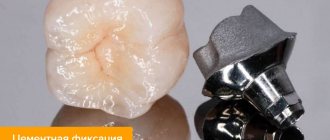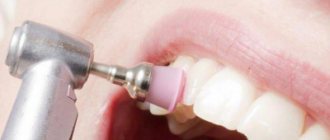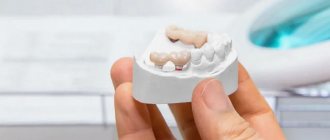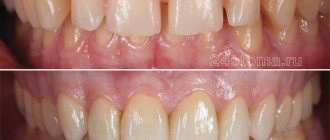Today, many patients when visiting dentistry complain about the loss of the natural shade of tooth enamel. Why does enamel become dull and lose its natural color? There are actually a huge number of reasons, and it is to them that we will pay attention today, but a little further. Now we note that this problem can be dealt with using modern teeth whitening technologies, Zoom whitening, Brite Smile, Opalescence, which are successfully used in medical science.
Changing the color shade of tooth enamel: varieties
There are two types of loss of natural tooth enamel color:
- Internal change. Occurs in the inner part of the tooth structure - dentin. The tooth becomes covered with gray, yellow spots or darkens.
- External change. The process takes place in the outer layer; deterioration is indicated by the appearance of yellow spots, white stripes, and dips on the surface of the tooth.
It is worth noting that external discoloration can be treated with special whitening technologies. Internal change is more difficult to cure. Its treatment may require aesthetic methods, such as veneers.
Features of baby teeth
The first teeth of babies have porous, thin enamel, which cannot effectively resist the attack of harmful microorganisms. The pulp cavity is wide. Once bacteria gets inside, they spread quickly. If a child has a weakened immune system, the pathogenic process affects the “neighbors.” Carious lesions are possible even in a one-year-old baby. We are talking about the so-called “bottle” caries, when the baby falls asleep while feeding. The sweet mixture remaining in the mouth creates favorable conditions for the development of pathogenic microflora.
Since caries in children progresses quickly, after some time the dentin is damaged. A carious cavity forms inside. But there is not always a visible stain on top. Blackening of the tooth from the inside may occur. Various factors contribute to the development of caries:
- insufficient hygiene is a common occurrence in children;
- genetic predisposition;
- poor nutrition, including excessive consumption of sweets;
- the influence of negative factors during the formation of teeth in the embryo - previous illnesses of the pregnant woman, taking certain medications.
Saliva has antibacterial properties and helps neutralize bacteria. In children this function is not as pronounced as in adults. She is also depressed by non-compliance with hygiene rules and a large amount of sweets in the diet.
The main reasons for changes in the shade of tooth enamel
- Consumption of food and drinks. Internal spoilage can occur from eating a wide variety of foods if proper oral care is not maintained.
- Tobacco use causes damage to the outer layer of tooth enamel.
- Inadequate dental care. If you do not brush your teeth regularly or with low-quality toothpastes, there is a risk of discoloration of the enamel.
- Use of medications. Any medications for high blood pressure can affect your dental health. If a pregnant woman uses tetracycline antibiotics, there is a risk of loss of color of the enamel and the newborn.
- Diseases. There are some infections in pregnant women that can affect the color of the newborn's tooth enamel, and teeth can also lose their natural color in case of dentin disease.
- The presence of dentures in the case of using silver amalgam during care can give the enamel a grayish tint.
- Genetic predisposition.
- Aging. As you age, tooth enamel may become yellowish. Also, soft or hard plaque may form on the surface of the teeth, which also causes discoloration of the teeth.
- Medical procedures. There are procedures, for example, chemotherapy, in which one of the side effects is the effect on the color of tooth enamel.
Most often, a person can cope with the problem, especially if it is caused by an external discoloration. All that is required is regular visits to the dental office and proper hygiene using quality toothpastes.
Immediately after eating food or drinks (red wine, tea, coffee), it is recommended to immediately rinse your teeth with water, but it is better to brush your teeth with toothpaste. After smoking, it is also necessary to brush your teeth, otherwise an unpleasant yellowish tint may appear on the tooth enamel in the near future.
Endogenous (internal) factors
Internal causes of teeth staining are more complex and multifaceted than external ones. It should be understood that under certain conditions these can occur in childhood. For example, if a child consumes too much fluoride during a change in bite, his teeth may acquire a certain shade, regardless of hereditary or national characteristics. From the clinical practice of our specialists, it is clear that enamel that has undergone changes due to internal factors whitens worse. Often, to achieve optimal results, it is necessary to eliminate the root cause of the problem. Endogenous factors for tooth staining:
- Disturbances in the development of dentin and enamel in childhood and adolescence (fluorosis);
- Metabolic disorders (erythropoietic porphyria, exposure to bilirubin, etc.);
- Schematic use of antibiotics of the tetracycline group;
- Root resorption;
- Age-related changes in enamel.
With age, teeth can also change their shade. This occurs against the background of thinning enamel in older people. At the same time, secondary dentin is formed in the internal structures of their teeth, which aggravates the situation. The enamel loses its transparency, causing the teeth to look dark and matte, which is called the “senile smile.” Sometimes tooth staining is associated with internal chronic pathologies of a systemic type, especially if they accompany the patient for most of his life. An equally common trigger for the violation of the natural whiteness of the enamel in this case is constant treatment. We must not forget that some medications negatively affect dental tissue. And if you take them constantly, you can achieve a permanent deterioration in the aesthetic qualities of your smile.
Dental abnormalities that may cause discoloration of tooth enamel
Changes in tooth color can occur as a result of changes in their size or shape. The color of the tooth may change depending on the number of teeth and the period of eruption.
Complete edentia is extremely rare, but the absence of several teeth is a common pathology. It is explained by endocrine disorders, which can cause a delay in teething and, as a result, a change in color.
With tuberculosis, neurological diseases, rickets, retention of the molars, as well as the upper canines (permanent), occurs.
In diseases associated with osteogenesis, patients most often have small teeth and a bluish tint to the tooth enamel. It is worth noting that the teeth of people with such diseases wear out quickly and are especially susceptible to disease. Pathologies in the development of dental dentin and tooth enamel cause amber, opal, bluish and brown tints of teeth and insufficient size.
What to do with a darkened tooth
If a tooth has darkened, the first thing to do is to determine the cause of the problem. The situation with coffee lovers and smokers is clear - they should have their teeth professionally cleaned by a specialist and adjust their habits. In the future, you can sign up for whitening, but first you will have to prepare yourself mentally, because after it, smoking and drinking coloring drinks are strictly prohibited for some time.
If the enamel of your teeth has darkened due to medications, then you need to either limit their intake or switch to other medications if the attending physician approves. To reduce your exposure to liquid coloring medications, drink them through a straw. If it is impossible to change the therapy, and the pigmentation causes severe discomfort, then installing veneers will help - plates that replace the top layer of enamel.
Only a qualified dentist can make a correct diagnosis. Therefore, the best thing to do if a tooth has darkened is to go to see a doctor. It will determine the presence or absence of a pathological process. There is no need to postpone your visit. If the cause of the color change is inflammation, then an assessment of the situation by a specialist is necessary. Internal inflammatory processes are not always accompanied by acute pain. If you neglect other signs, then you may subsequently encounter not only chronic pulpitis, but also other unpleasant pathologies, such as granuloma, periodontitis, and radicular cyst.
Granuloma and cyst are formations with purulent or serous fluid inside. Their development can proceed practically asymptomatically for some time, making itself known only by a change in color. But then you cannot do without serious interventions: cutting tissue, removing part of the root, or even the entire tooth. Purulent inflammation can even damage the jaw bone. In this case, you cannot do without tooth extraction.
Removal is necessary in the following situations:
- the inflammation spread to the area around the tooth and affected the jawbone;
- the tooth is loosened and the gums are bleeding due to internal injury;
- the crown is too destroyed, less than 30% of hard tissue remains;
- the tooth is split, and the split continues inside the gum.
In the latter case, it is possible to preserve the roots of the tooth, but the cracked upper part will still be removed and replaced with a prosthesis.
It is clear that if a tooth suddenly darkens, an examination should be done immediately. To save a tooth, you need to see a dentist immediately. If there is inflammation, the doctor will remove the infected tissue and fill the voids. After treatment, it may be necessary to bleach not the outer part, but the inner part of the crown, since it was this part that darkened due to the death of the pulp or its remains. Often after this, the teeth return to their former whiteness and natural appearance. In other cases, when lightening and restoration with filling materials are impractical, but removal is not required, partial or complete “artificial enamel” is created for the tooth - veneers or crowns are installed.
To whiten a pulpless, darkened tooth, the doctor brightens it from the inside. To do this, he opens the canals, cleans them and fills them with a bleaching compound. Until the composition lightens the tissue, the patient will have a temporary filling. This procedure is called endobleaching. In some cases, it may take several sessions.
If the tooth walls are too thin, or there are other contraindications for whitening, then, depending on the situation, the dentist will select alternative methods: direct restoration with composite material, installation of veneers, lumineers or crowns. Positive aspects of restoration with composite material:
- ease of implementation - the tooth is covered with a composite composition, forming one large filling on its surface;
- speed of implementation - can be done in one visit to the doctor;
- affordable price.
Disadvantages of such restoration:
- composite material is easy to paint, you will have to change your eating habits;
- fragility - average service life is about 5 years;
- During repeated restoration, the integrity of the tooth walls suffers.
How to restore the color of tooth enamel?
In many cases, with the exception of diseases and pathologies, patients have every chance to influence and change the color of tooth enamel for the better, without even going to the dentist. The surest way is to eliminate all foods and drinks that contain food colorings.
In difficult cases, various modern technologies, professional teeth cleanings help restore whiteness, and in the most difficult cases, prosthetics are performed.
There are many ways to restore the natural color of enamel; by contacting our center, each patient can count only on quality, namely the complete restoration of tooth enamel.
How to keep your teeth white
To keep your teeth white, you need to:
- Perform good oral hygiene, including brushing, flossing, and using mouth rinse
- Using a waterpik at least twice a week to get rid of plaque
- Once or twice a year, have your mouth professionally cleaned by a dental hygienist to remove tartar.
- Limit or eliminate smoking, strong tea and coffee
It is also important to make regular visits to the dentist for diagnostic procedures. This will allow timely identification of problems and identification of deterioration of the enamel.
Symptoms accompanying tooth darkening
If the cause of the defect is a bruise, then the symptoms will be pronounced. More often, the impact damages the upper or lower front teeth. At the same time, the baby feels pain, which only increases over time. Pain is especially evident when pressing on a sore spot or chewing food. In addition to pain and staining, other symptoms may occur:
- poor tooth mobility;
- swelling of the gums;
- hyperemia;
- deformation of individual areas of the mucosa;
- formation of hematomas;
- increase in temperature (in some cases).
If the blow to the jaw was strong, the ligaments at the site of the injury may be torn, the joint may be damaged, or the alveolar process may be fractured. When trying to open or close the jaw, the child will experience pain.











